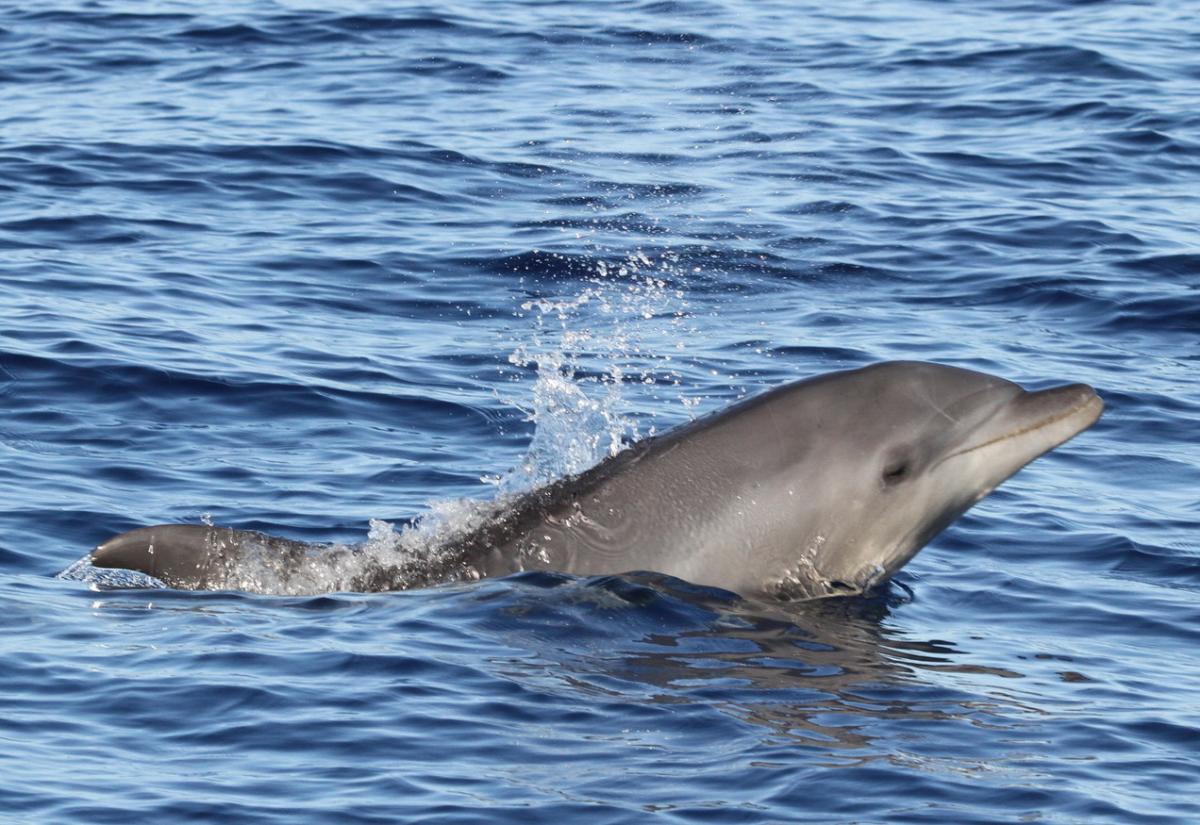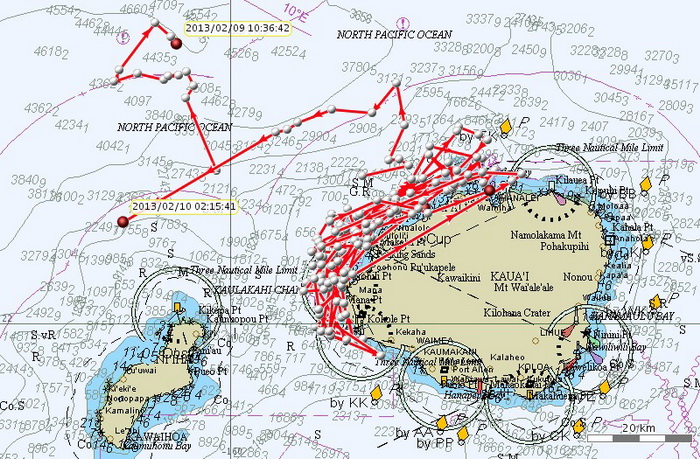Cascadia Research will be undertaking an 8-day field project off the island of Kaua‘i starting February 2nd, 2013. This will be our 8th field project (and 6th year) working off Kaua‘i and Ni‘ihau. The primary purpose of the project is to obtain information on movements and habitat use of a number of species of toothed whales through the deployment of satellite tags. We will also be obtaining photos from most species of odontocetes we encounter, to contribute to ongoing studies of residency patterns and social organization and to estimate population sizes. We will also be collecting biopsy samples for toxicology and genetic studies. In the last two years we’ve had similar field projects in July and early August of 2011 (download a report from that effort here), and June and July of 2012, and like those projects we expect to have higher encounter rates than normal since we’ll be working in collaboration with the Marine Mammal Monitoring on Navy Ranges (M3R) program, using the Navy’s hydrophone range off Kaua‘i (see map below) to localize animals. When on the water we will be in constant contact with Navy researchers from the M3R program to help direct us to groups that they are detecting acoustically. This will allow us to confirm the species (to aid in using the acoustic range for research purposes on different species), and should make it much easier for us to find groups of whales and dolphins for tagging, photo-ID and biopsy sampling.
Species that we are hoping to satellite tag include rough-toothed dolphins, bottlenose dolphins, false killer whales, short-finned pilot whales, melon-headed whales, pygmy killer whales, sperm whales, Cuvier’s beaked whales, and Blainville’s beaked whales.
The research team includes Daniel Webster and Jessica Aschettino, as well as Annie Gorgone and Brenda Rone. This work is being funded by Commander, Pacific Fleet.
February 9th, 2013 update

Bottlenose dolphin, February 9th, photo by Jessica Aschettino
February 9th was our last day on the water for this trip, and we were able to deploy another satellite tag on a bottlenose dolphin.

Tracklines from the field project. Despite the usual winter weather we were able to spend a fair amount of time in deep water.

Map showing movements of the three species tagged during this project: bottelnose dolphin, rough-toothed dolphin and short-finned pilot whale. The map showings only high-quality satellite locations, since the first tag was deployed February 2nd.

Black-footed Albatross, February 9th, photo by Daniel Webster
February 8th, 2013 update

Close-up photo of the head of a rough-toothed dolphin bowriding on our research vessel, February 8, 2013. Photo by Jessica Aschettino. A good day on the water today, with encounters with two groups of rough-toothed dolphins. We were able to deploy a depth-transmitting satellite tag on one individual.

Rough-toothed dolphins, February 8, 2013. Photo by Jessica Aschettino

Short-finned pilot whales, February 8, 2013. Photo by Brenda Rone. We also encountered our first group of pilot whales for the trip, and were able to deploy two depth-transmitting satellite tags, as well as collect one biopsy sample and photo-ID most of the individuals present.

Adult male short-finned pilot whale, February 8, 2013. Photo by Brenda Rone. This individual, HIGm1407 in our catalog, was first seen off Oahu in 2009 and was seen in our February 2011 field project
February 6th, 2013 update

Bottlenose dolphins and humpback whale, February 6th, 2013, photo by Jessica Aschettino. On February 6th we encountered a group of about 12 bottlenose dolphins that included the individual tagged on February 4th.

Bottlenose dolphins, February 6th, 2013, photo by Brenda Rone. We also encountered one of the bottlenose dolphins we satellite tagged in June 2012 (the left-hand individual in this photo – the two gray dots on the middle of the fin are the scars where the darts attached).

Black-footed Albatross, February 6th, 2013, photo by Jessica Aschettino
February 5th, 2013 update

A humpback whale in a competitive group, February 5, 2013, photo by Daniel Webster. In the last two days we’ve had several encounters with humpback whales and bottlenose dolphins, and were able to deploy another depth-transmitting satellite tag on a bottlenose dolphin. The map below shows movements of the first tagged bottlenose dolphin over the last few days.

February 3rd, 2013 update

Spinner dolphins, February 3, 2013. Photo by Brenda Rone.
Another good day on the water today with seven encounters with three species of odontocetes: bottlenose dolphins, spinner dolphins, and rough-toothed dolphins. We re-encountered the group of bottlenose that included the tagged individual from yesterday and were able to get some follow-up photos as well as identifications photos from several other groups.

Spinner dolphin with barnacles protruding from the mouth, February 3, 2013. Photo by Brenda Rone. This individual must have some sort of mouth-line injury that has allowed stalked barnacles to anchor on exposed teeth, visible on the left side of the mouth.

Spinner dolphins with humpback whales, February 3, 2013. Photo by Jessica Aschettino. The spinner dolphin group today, with an estimated 22 individuals, with mixed in with three humpback whales.
February 2nd, 2013 update

A bottlenose dolphin leaping off Kauai, February 2, 2013. Photo by Brenda Rone.
Our first day on the water was a productive one, with an encounter with a group of 35 bottlenose dolphins. We were able to photo-identify about 30 individuals, and deployed one depth-transmitting satellite tag.

A bottlenose dolphin leaping off Kauai, February 2, 2013. Photo by Jessica Aschettino.

Our study area for the project. The Navy’s hydrophone range it shaded – approximately 175 hydrophones are spread across the shaded area connected to the M3R system.
Sign up to our Facebook page if you want to receive notices of when information is posted and updates on other Cascadia projects.